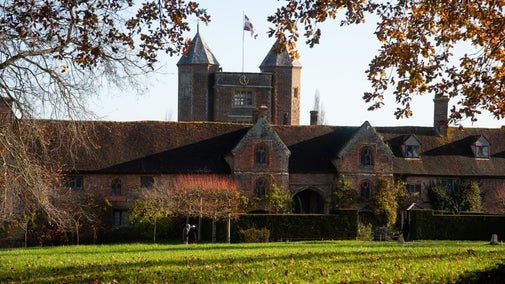
Discover more at Sissinghurst
Find out when Sissinghurst Castle Garden is open, how to get here, the things to see and do and more.

Sissinghurst Castle Garden’s past is a complicated one, spanning many centuries, monarchs and uses. Delve into the past of one of the most intriguing places in the Weald of Kent.
The site that Sissinghurst Castle Garden sits on was once a Saxon pig farm, it would have been originally called 'Saxenhurst,' with 'hurst' having meant woodland.
The Tudor buildings were used as a prison for up to 3,000 French sailors who were captured by the British during the Seven Years War, between 1756-63. Held for months at a time in vile, stinking conditions, the prisoners lived in 'cells' with little access to fresh air, clean water or adequate food supplies.
The sailors referred to Sissinghurst as 'le chateau' hence 'castle' being adopted into its name, although not a direct translation.
An original ink and dye drawing on display in the library gives a remarkable insight into what the Sissinghurst site would have looked like in the 18th century.

In 1796 the Cranbrook 'Councillors' took out a lease on Sissinghurst from the owners at the time, the Mann-Cornwallis family. This was to be used as a poor house for the able-bodied. Around 100 men were offered housing, employment and food. The owners repaired many of the buildings and their legacy is apparent even today: on the weathervanes you can see the markings MC 1839.
The inmates worked the farm, which became profitable, for the local parish. When the estate reverted back to the Cornwallis family in 1855 it was the beginning of a great period of Victorian 'high farming', and the Sissinghurst farm was deemed to be the best on the whole of the substantial Cornwallis estate.
When Vita Sackville-West and Harold Nicolson bought Sissinghurst in early 1930 it looked quite different to the present day. The buildings were used to house farm workers, the current famous garden had yet to be laid out and was mostly used to grow vegetables for the workers. The surrounding farm was growing cereals as well as having well established orchards and hop gardens.
None of the buildings were inhabitable and the grounds were full of rubbish: old sardine tins, cabbage stalks and rusty bedsteads littered the ground. None of this mattered to Vita, who saw its great potential.
- Vita Sackville-West on Sissinghurst
It was the romance of the place that appealed to Vita. No matter that there was nowhere to live: the walls and space were all that mattered, for they gave her the opportunity to create a garden where she could grow all her favourite plants in abundance.

Vita loved old roses and at Sissinghurst she finally had the space to indulge in her passion. Her vision was for ‘a tumble of Roses and Honeysuckle, Figs and Vines.’
She and Harold made the Rose Garden in what had once been a kitchen garden and this she filled lavishly with all her favourite old roses.
Vita was a gifted amateur who gardened instinctively and without the desire for perfection. When it came to planting, she didn’t want to see the soil but vibrant flowerbeds bursting with colour. Harold took a more classical approach to the garden, feeling more comfortable with straight lines that could create a framework for planting.
Inspired by the land, Vita and Harold created spaces which provided views for miles around. The result of their work is what you see today, a refuge dedicated to beauty.
The garden at Sissinghurst Castle opened to the public in the late 1930s. The admission fee was one shilling, hence Vita's name for visitors to the garden: shillingses. Visitors would often leave their admission charge in an old tobacco tin on a table under the entrance archway.
A photograph of the library found in the collection at Sissinghurst Castle shows how it would have appeared in the 1940s. Prior to its conversion, this large, long room formed part of the stables.
Vita and Harold transformed the room by adding a large window, building a stone fireplace using fragments of the Elizabethan ruin found in the garden, and panelling the walls in dark oak. It wasn't used often by Vita and Harold unless they had important and grand guests.
During the Second World War the shorthorn dairy cow enterprise continued. The milking and day-to-day operation of the herd were assisted by members of the Women’s Land Army (WLA), waking at 5.30am to milk the cows. Vita was heavily involved in the organisation and welfare of the WLA in Kent.
By the 1950s Sissinghurst was a working farm with a yard and machinery all over the site. Several of the buildings no longer exist while those that remain have a completely different use today; the gift shop was once the piggery and the restaurant was the granary.

Find out when Sissinghurst Castle Garden is open, how to get here, the things to see and do and more.
Find out more about the final phase in developing the Delos garden at Sissinghurst Castle, reimagined from Vita and Harold’s original vision.

Explore the garden at Sissinghurst, with its vibrant planting schemes and architectural planning, and discover why it ranks among the most famous gardens in England.

Climb the Tower at Sissinghurst for views of the whole garden and peruse thousands of books in the Library.

Learn about people from the past, discover remarkable works of art and brush up on your knowledge of architecture and gardens.

From landscape gardeners to LGBTQ+ campaigners and suffragettes to famous writers, many people have had their impact on the places we care for. Discover their stories and the lasting legacies they’ve left behind.

Explore the objects and works of art we care for at Sissinghurst Castle Garden on the National Trust Collections website.